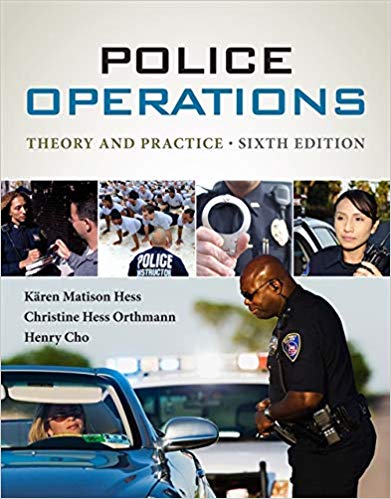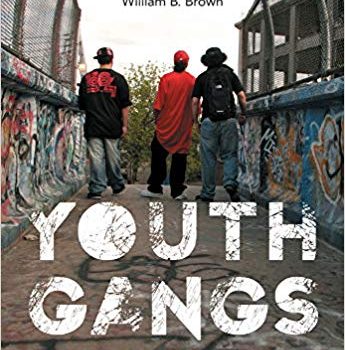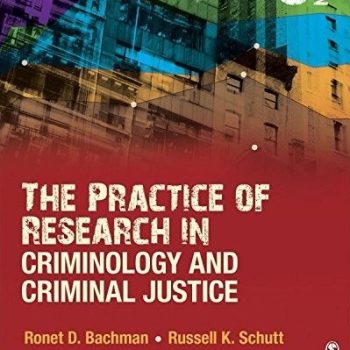Test Bank For Police Operations Theory and Practice 6th Edition by Kären M. Hess
CHAPTER 3: OPERATIONAL SKILLS: PERFORMING WITHIN THE LAW
MULTIPLE CHOICE
1.The ____________ Amendment stresses the importance of having an arrest warrant when making an arrest.
|
a. |
First |
|
b. |
Fourth |
|
c. |
Fifth |
|
d. |
Sixth |
|
e. |
No amendment specifically refers to the importance of having an arrest warrant |
ANS:BPTS:1REF:(p. 84)
OBJ: How officers arrest someone.
2.The balance law enforcement officers must maintain, “freedom to” versus “freedom from,” is analogous to
|
a. |
victims versus criminals. |
|
b. |
lawbreakers versus law-abiding citizens. |
|
c. |
due process versus crime control. |
|
d. |
the First Amendment versus the Fourteenth Amendment. |
|
e. |
stop versus frisk. |
ANS:CPTS:1REF:(p. 79)
OBJ: What balance between freedom and order police officers must maintain.
3.Guarantees against unlawful searches and seizures and arrests are found in
|
a. |
the police code of ethics. |
|
b. |
a department’s policy manual. |
|
c. |
amendments to the Constitution. |
|
d. |
officers’ general orders. |
|
e. |
the Declaration of Independence. |
ANS:CPTS:1REF:(p. 79)
OBJ: What two amendments restrict arrests and searches.
4.The three main exceptions to the exclusionary rule include each of the following except
|
a. |
the inevitable discovery doctrine. |
|
b. |
good faith. |
|
c. |
a valid independent source. |
|
d. |
none of the other choices are exceptions. |
|
e. |
all of the other choices are exceptions. |
ANS:EPTS:1REF:(pp. 115–117)
OBJ: What the exclusionary rule is and its relevance to police operations.
5.Making an arrest is one of the most
|
a. |
difficult decisions to make because of the “gray” area of law. |
|
b. |
extreme steps a law officer may make. |
|
c. |
dangerous tasks officers perform. |
|
d. |
none of the other choices. |
ANS: B PTS: 1 REF: (p. 84) OBJ: What constitutes an arrest.
6.The precedent case for the legality of and restrictions on “stop and frisk” is
|
a. |
Miranda v. Arizona. |
|
b. |
Tennessee v. Garner. |
|
c. |
Chimel v. California. |
|
d. |
Mapp v. Ohio. |
|
e. |
Terry v. Ohio. |
ANS:EPTS:1REF:(p. 107)
OBJ:What a stop-and-frisk situation involves.
7.Except in the case of a Terry stop, an officer’s probable cause to conduct an arrest depends on
|
a. |
what the officer knew before taking action. |
|
b. |
what the officer learned while taking action. |
|
c. |
what the officer surmised after taking action. |
|
d. |
all of the other choices. |
|
e. |
none of the other choices. |
ANS:APTS:1REF:(p. 85)
OBJ:Why understanding and skill in making legal arrests are critical.
8.A traditional standard against which to measure reasonable police use of force is
|
a. |
whether the suspect poses an immediate threat to the public or officers. |
|
b. |
whether the suspect is actively resisting arrest or attempting to flee. |
|
c. |
the severity of the crime. |
|
d. |
all of the other choices. |
|
e. |
none of the other choices. |
ANS:DPTS:1REF:(p. 91)
OBJ: What three use-of-force tests are established in Graham v. Connor.
9.“In the presence” refers to
|
a. |
proximity. |
|
b. |
within the officer’s senses. |
|
c. |
immediacy in time. |
|
d. |
all of the other choices. |
|
e. |
none of the other choices. |
ANS:BPTS:1REF:(p. 85)
OBJ:When officers may arrest someone.
10.A detention without probable cause that is factually indistinguishable from an arrest is known as a _________ arrest.
|
a. |
“hunch” |
|
b. |
de facto |
|
c. |
Carroll |
|
d. |
Miranda |
|
e. |
misdemeanor |
ANS:BPTS:1REF:(p. 87)
OBJ: How officers arrest someone.









Reviews
There are no reviews yet.